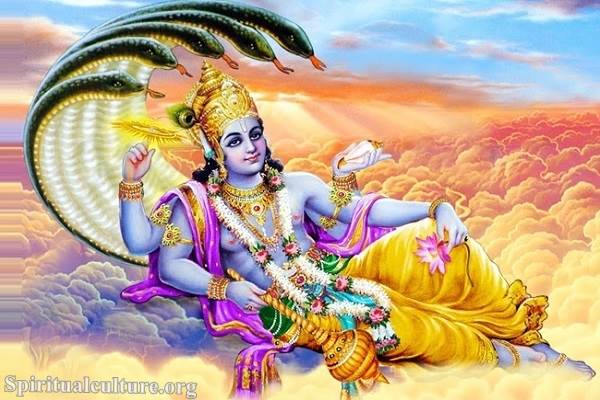The blue complexion of deities carries symbolic and cultural significance and is associated with various attributes and cosmic themes.

Here are some key aspects of the symbolism of blue skin in Hinduism:
Cosmic Symbolism:
The blue skin of deities, particularly Lord Vishnu, often represents the vast expanse of the sky and the boundless cosmic ocean. The color blue is associated with the infinite and the transcendent nature of the divine.
Transcendence and Immanence:
The blue skin signifies the simultaneous qualities of transcendence and immanence in Hindu theology. While the divine is beyond the material world, it manifests within it. The blue color suggests a divine presence that pervades the entire cosmos.
Infinite and Formless:
The blue hue represents the formless and infinite aspect of the divine. It suggests that physical boundaries do not confine the deity and transcend the limitations of the material world.
Representation of the Divine Ocean:
Blue is associated with the color of water, and water is often seen as a symbol of the cosmic ocean. With their blue skin, the deities are sometimes seen as emerging from or residing in the cosmic ocean, emphasizing their divine origin and connection to the primordial waters.
Protection and Preservation:
Lord Vishnu, known as the preserver of the universe, is often depicted with blue skin. The blue symbolizes his role in protecting and preserving the cosmic order (dharma) and maintaining the balance between creation and destruction.
Association with Nila Saraswati:
In some traditions, the goddess Saraswati, associated with knowledge and wisdom, is depicted with blue skin. She is known as Nila Saraswati, where “nila” means blue. This representation emphasizes the divine wisdom that transcends worldly knowledge.
Symbol of Bliss:
In Hindu philosophy, Blue is sometimes associated with the state of bliss (ananda). With its blue skin, the divine is seen as the embodiment of eternal joy and spiritual ecstasy.
Bhakti (Devotion):
In devotional practices, the blue skin is often seen as an invitation for devotees to develop a deep emotional connection with the deity. The divine’s unconventional appearance, such as blue skin, encourages a personal and heartfelt relationship with the worshippers.
Artistic Tradition:
The tradition of depicting deities with blue skin is deeply rooted in Hinduism’s artistic and iconographic traditions. Artists use vibrant blue pigments to represent the divine in various forms of art, including sculptures, paintings, and images.
Cultural Variations:
While Lord Vishnu is perhaps the most well-known deity with blue skin, other deities like Lord Krishna are also depicted with a blue complexion. Different cultural and regional variations may attribute different meanings to the blue skin of specific deities.
In essence, the blue skin of deities in Hinduism symbolizes the divine’s transcendental, infinite, and cosmic nature, inviting devotees to contemplate the profound mysteries of existence and cultivate a sense of devotion and connection to the divine presence.




